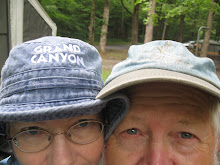Enjoying Laurel Falls with family in July 2011, less than 90 days after I had a stroke
During our July visit to the Great Smoky Mountains National Park last year, I was in the early stages of relearning how to move about safely following a stroke. The damage caused by a burst blood vessel in the right side of my brain had left me weak and without normal movement on my entire left side.
Thanks to family, my physical deficits did not diminish my experiencing the restorative joy that mountain environments offer me. Strong sons and hubby wheeled me around, and up and down, in a wheelchair, including on a 1.3-mile uphill hike to 80-foot Laurel Falls and back down. Talk about a thrill ride!
I also spent many happy moments in a sturdy camping chair, soaking up the exuberance of our grown sons, their wives and our grandchildren experiencing everything from tubing the rapids to roasting marshmallows and assembling s’mores.
More than a dozen steps pushed my limit at that time, and those steps were only accomplished on flat, even surfaces with a strong adult holding fast to my gait belt as insurance in case I lost my balance.
This year my balance and strength have increased dramatically.
Traditional family photo July 2011
Traditional family photo July 2012
Before we left for our Smokies trip, my physical therapist suggested that I acquire a hiking stick. On Day 3 in the Smokies, I took her advice and purchased one at the park’s Oconaluftee Visitor Center outside Cherokee, NC.
Ready to move in the mountains with my new hiking stick
The new addition to my collection of “assistive devices” didn’t cause me to see a burning bush nor did it turn into a snake as Moses’ staff did in the Old Testament. The one Moses wielded played a role in achieving freedom for the Israelites.
My hiking stick played a role in achieving freedom, too, my freedom to successfully navigate modest but challenging walks on Smoky Mountain paths of changing elevation and terrain uneven from exposed roots, erosion and broken asphalt. Some of those walks were even solo.
And I used it early this morning for my first solo walk part of the way around our circle.
*****
A break for stroke nomenclature: Med Terms Web site defines assistive device as “Any device that is designed, made, or adapted to assist a person perform a particular task. For examples, canes, crutches, walkers, wheel chairs, and shower chairs are all assistive devices.”
*****
The term fits, and in spite of its inelegant, bureaucratic ring, I appreciate the existence of such devices. I have used nine or more different ones during my recovery and still use four regularly and two or three others as circumstances warrant.
My new hiking stick did not, however, achieve freedom from looks directed my way during our camping vacation. My footwear was the culprit. I hadn’t managed to purchase additional walking shoes in a narrow size before we left. I have a pair of narrow athletic shoes in white that I wear with my Bioness system of electrodes. When the Bioness is not charged up, I resort to a brace that fits into a wider black shoe.
The matching black shoe for my right foot is not narrow enough to keep my toes from sliding down and jamming into the front of the shoe. I was happy that the white athletic shoe for my right foot offered the option of comfy toes. I just wore my mismatched shoes and answered all puzzled glances with a smile, content with my Smoky Mountain therapy.





Linda,
ReplyDeleteYou've come such a long way this past year! From a wheelchair to a walking stick :) What a feeling of accomplishment you must have, as well as the knowledge that God indeed answers prayers.
I love your stick, by the way, and who knows, you may inspire a new fashion trend with those mis-matched shoes...
Your family photos, beside the sign, are beautiful. I'm glad you shared them.
Thanks, Kathy. God has answered prayers indeed!
ReplyDeleteI too think about Moses when I use my walking stick. Very helpful device. Congratulations. You've come a long way baby. Dianne
ReplyDelete